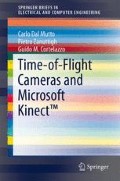Abstract
The Microsoft Kinect™ range camera (for simplicity just called Kinect™ in the sequel) is a light-coded range camera capable to estimate the 3D geometry of the acquired scene at 30 fps with VGA (640 x 480) spatial resolution. Besides its lightcoded range camera, the Kinect™ also has a color video-camera and an array of microphones. In the context of this book the Kinect™ light-coded range camera is the most interesting component, and the name Kinect™ will be often referred to it rather than to the whole product.
Access this chapter
Tax calculation will be finalised at checkout
Purchases are for personal use only
Preview
Unable to display preview. Download preview PDF.
References
Primesense. http://www.primesense.com/.
Asus, “Xtion pro.” http://www.asus.com/Multimedia/Motion Sensor/Xtion PRO/.
J. Smisek, M. Jancosek, and T. Pajdla, “3d with kinect,” in 1st IEEE Workshop on Consumer Depth Cameras for Computer Vision, 2011.
K. Konoldige and P. Mihelich, “Technical description of kinect calibration,” tech. rep.,Willow Garage, http://www.ros.org/wiki/kinect calibration/technical, 2011.
Salvi J, Pags J, Batlle J (2004) Pattern codification strategies in structured light systems. Pattern Recognition 37:827–849
Carrihill B, Hummel R (1985) Experiments with the intensity ratio depth sensor. Computer Vision, Graphics, and Image Processing 32(3):337–358
J. Tajima and M. Iwakawa, “3-d data acquisition by rainbow range finder,” in Proceedings of the 10th International Conference on Pattern Recognition, 1990.
M. Trobina, “Error model of a coded-light range sensor,” tech. rep., Communication Technology Laboratory Image Science Group, ETH-Zentrum, Zurich, 1995.
Bergmann D (1995) “New approach for automatic surface reconstruction with coded light”, in Proc. Remote Sensing and Reconstruction for Three-Dimensional Objects and Scenes, SPIE
Maruyama M, Abe S (1993) Range sensing by projecting multiple slits with random cuts. IEEE Transactions on Pattern Analysis and Machine Intelligence 15:647–651
Boyer K, Kak A (1987) Color-encoded structured light for rapid active ranging. IEEE Transactions on Pattern Analysis and Machine Intelligence 9:14–28
Etzion T (1988) Constructions for perfect maps and pseudorandom arrays. IEEE Transactions on Information Theory 34(5):1308–1316
“Patent application us2010 0118123,” 2010.
Morano R, Ozturk C, Conn R, Dubin S, Zietz S, Nissano J (1998) Structured light using pseudorandom codes. IEEE Transactions on Pattern Analysis and Machine Intelligence 20:322–327
Szeliski R (2010) Computer Vision: Algorithms and Applications. Springer, New York
D. Scharstein and R. Szeliski, “A taxonomy and evaluation of dense two-frame stereo correspondence algorithms,” International Journal of Computer Vision, 2001.
G. Bradski and A. Kaehler, Learning OpenCV: Computer Vision with the OpenCV Library. O’Reilly, 2008.
J. Shotton, A. Fitzgibbon, M. Cook, T. Sharp, M. Finocchio, R. Moore, A. Kipman, and A. Blake, “Real-Time Human Pose Recognition in Parts from Single Depth Images,” in CVPR, 2011.
“Willow garage turtlebot.” http://www.willowgarage.com/turtlebot.
S. Izadi, D. Kim, O. Hilliges, D. Molyneaux, R. Newcombe, P. Kohli, J. Shotton, S. Hodges, D. Freeman, A. Davison, and A. Fitzgibbon, “KinectFusion: real-time 3D reconstruction and interaction using a moving depth camera,” in Proceedings of the 24th annual ACM Symposium on User Interface Software and Technology, 2011.
Author information
Authors and Affiliations
Rights and permissions
Copyright information
© 2012 The Author(s)
About this chapter
Cite this chapter
Mutto, C.D., Zanuttigh, P., Cortelazzo, G.M. (2012). Microsoft Kinect™ Range Camera. In: Time-of-Flight Cameras and Microsoft Kinect™. SpringerBriefs in Electrical and Computer Engineering(). Springer, Boston, MA. https://doi.org/10.1007/978-1-4614-3807-6_3
Download citation
DOI: https://doi.org/10.1007/978-1-4614-3807-6_3
Published:
Publisher Name: Springer, Boston, MA
Print ISBN: 978-1-4614-3806-9
Online ISBN: 978-1-4614-3807-6
eBook Packages: EngineeringEngineering (R0)

